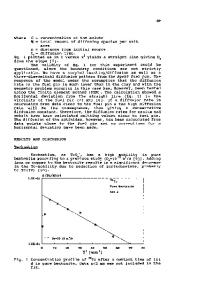Migration Behaviour of Ferrous Ion in Compacted Bentonite Under Reducing Conditions Controlled With Potentiostat
- PDF / 752,617 Bytes
- 8 Pages / 612 x 792 pts (letter) Page_size
- 6 Downloads / 329 Views
Migration Behaviour of Ferrous Ion in Compacted Bentonite Under Reducing Conditions Controlled With Potentiostat Kazuya Idemitsu, Syeda Afsarun Nessa, Shigeru Yamazaki, Hirotomo Ikeuchi, Yaohiro Inagaki, Tatsumi Arima, Dept. of Applied Quantum Physics and Nuclear Engineering, Kyushu Univ., Fukuoka, JAPAN ABSTRACT Carbon steel overpack is corroded by consuming oxygen introduced by repository construction after closure of the repository and then maintains the reducing environment in the vicinity of the repository. The migration of iron corrosion products through the buffer material will affect the migration of redox-sensitive radionuclides. Therefore, it is important to study the migration of iron corrosion products through the buffer material because it may affect the corrosion rate of overpack, and migration of redox-sensitive radionuclides. Electromigration experiments have been conducted with the source of iron ions supplied by anode corrosion of the iron coupon in compacted bentonite. The carbon steel coupon was connected as the working electrode to the potentiostat and was held at a constant supplied potential between - 650 to +300 mV vs. Ag/AgCl electrode for up to 168 hours. The amount of iron penetrated into a bentonite specimen was in good agreement with the calculated value from the corrosion current under the assumption that iron is dissolved as ferrous ions. A model using dispersion and electromigration could explain the measured iron profiles in the bentonite specimens. The fitted value of electromigration velocity depended on the potential supplied. On the other hand the fitted value of the dispersion coefficient did not depend on the potential supplied but a constant. This constant dispersion coefficient could be due to the much larger diffusion coefficient of ferrous ion in bentonite compared with the effect of mechanical dispersion. The experimental configurations used in this study are applicable to the examination of the migration behaviour of cations with the source of iron ions under a reducing condition controlled with a potentiostat. INTRODUCTION Carbon steel is one of the candidate overpack materials for high-level waste disposal [1]. Carbon steel overpack is corroded by consuming oxygen introduced by repository construction after closure of the repository. Corrosion products diffuse into buffer materials and then maintain the reducing environment in the vicinity of the repository [2]. The reducing condition is expected to retard the migration of redox-sensitive radionuclides. For example, a rare study on plutonium diffusion in compacted bentonite is available. It has been reported that no movement could be measured for plutonium diffusion in a concrete-bentonite system under an oxidizing condition in an experimental period as long as 5 years [3]. Our research group succeeded in migrating plutonium about 1mm in bentonite within a week under a reducing condition by using the electromigration technique [4]. The result shows that plutonium has a higher diffusion coefficient under the reducing con
Data Loading...











